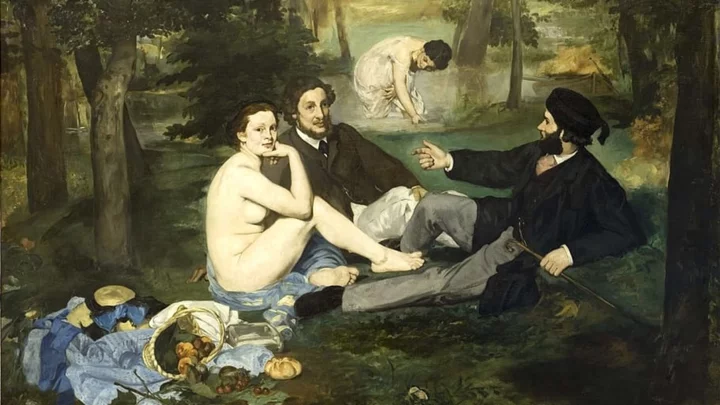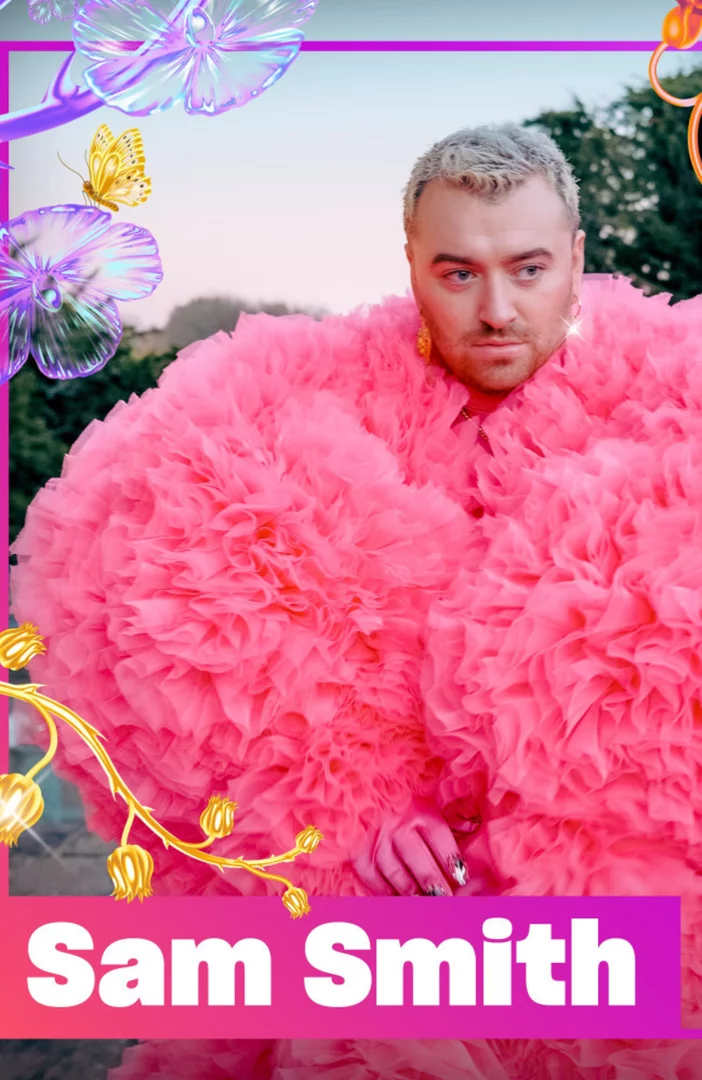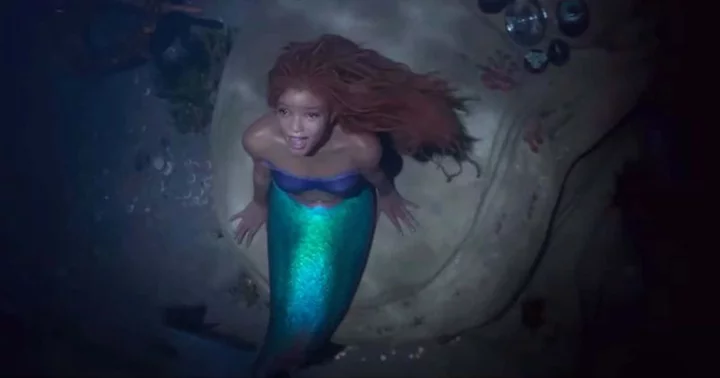This article contains affiliate links to products selected by our editors. Mental Floss may receive a commission for purchases made through these links.
Today, Le Déjeuner sur l’Herbe (Luncheon on the Grass) is regarded as 19th-century French artist Édouard Manet’s greatest triumph. But when its unusual take on classical nudes was first displayed, it shocked Paris and earned the artist a reputation as a reckless rebel.
1. The composition of Le Déjeuner sur l’Herbe is a nod to Raphael.
In 1515, High Renaissance artist Raphael designed Judgment of Paris. The intricately detailed print originated as a drawing by Raphael that master engraver and collaborator Marcantonio Raimondi then recreated as a print. More than 300 years later, Manet would pull inspiration and poses from the engraving’s lower right corner, where two men lounge with a woman whose elbow is perched on her raised knee.
2. Its concept was also borrowed from the Renaissance.
The mix of clothed men and casually nude women caused quite a stir among prim and proper Parisians, but it was not a new subject. Circa 1510, The Pastoral Concert (which used to be attributed to Giorgione but is now believed to be an early Titian) famously depicted a similar scene.
3. Parisian art critics jeered at Le Déjeuner sur l’Herbe.
Manet tried to get Le Déjeuner sur l’Herbe accepted by the Paris Salon in 1863, but the casual nudity of the women among clothed men in a public space so stunned the salon’s jury that they refused to display it. Manet was not alone in being snubbed that year—the stingy salon rejected so many artists that Napoleon III created an exhibition for this outcast art. Manet’s misfit masterpiece debuted at the Salon des Refusés (Salon of the Refused) with its fellow failed salon applicants.
4. Le Déjeuner sur l’Herbe stole the rejects’ show.
The secondary salon boasted names familiar to any art fan—including Pisarro, Whistler, and Cézanne—but Manet’s painting was the show’s standout. With its unconventional representation of nudity, the artwork became the subversive salon’s main attraction. But that doesn’t mean it was beloved. It’s said men scooted their wives past the piece as quickly as possible, then doubled back to gawk. Mostly, Manet’s work drew laughter and sneers. The public was scandalized.
5. The context surrounding Le Déjeuner sur l’Herbe was the source of the controversy.
Nude women had long been the subjects of classical art, but those were generally women meant to represent the divine. In Manet’s Le Déjeuner sur l’Herbe, the women were not goddesses. One’s shed clothes are clearly visible in the lower left corner. And the men in contemporary garb underline Manet’s intention of showing modern, real people in place of fantastical or classical figures. These details made the painting feel sexual in a way classical works did not. This collision led critics and the public to call the piece obscene. More alarming to detractors was that the woman in the foreground even dares to confrontationally look out at the viewer with no shame over her nakedness.
6. Manet originally called the painting Le Bain (The Bath).
The title Manet gave the painting for its debut supplies a milder explanation for the female nudity. But once the piece sparked controversy over its perceived sexual nature, the artist jokingly nicknamed it “la partie carrée,” which translates loosely to “the foursome.” As has happened with many great works of art, the painting’s name shifted along with the public’s perception of it.
7. The clothed men in Le Déjeuner sur l’Herbe were Manet’s relatives.
One is his brother, Eugène Manet. The other is his future brother-in-law, Dutch sculptor Ferdinand Leenhoff.
8. The bold nude woman was Manet’s favorite model.
Victorine-Louise Meurent was a popular muse of Parisian painters of the late 1800s. Her nickname, la crevette (the shrimp), referred to not only her petite size, but also her rosy complexion and red hair. She sat for Manet on a number of occasions, appearing Le Déjeuner sur l’Herbe and eight other pieces.
9. Manet and Meurent again shocked Paris with Olympia.
The pair collaborated on another nude that showed the redhead lounging on a white, unmade bed, once more calmly staring down her audience. Again breaking from classical tradition, this character seemed less like a fictional figure or a goddess and more like a flesh and blood woman owning her sexuality. When it debuted in 1865, it would mark one of the first times a female nude had been presented in such a realistic manner. As with Le Déjeuner sur l’Herbe, the art worled was stunned by Olympia.
10. Manet’s scandalous paintings hurt Meurent’s reputation.
Because of the intimacy projected in these pieces, many assumed that Manet and Meurent were lovers, but that was just the tip of the gossip iceberg. A popular reading of both Le Déjeuner sur l’Herbe and Olympia is that the brazenly naked women in the paintings must be prostitutes. This fueled rumors that Meurent herself was a sex worker who had met an alcohol-fueled end at a young age. In truth, she lived to be 83 and earned acclaim outside of Manet’s canvases.
11. Meurent was a painter in her own right.
In 1876, Meurent submitted a self-portrait to the Salon, and it was accepted while Manet’s submission was denied. She would again show at this prestigious venue in 1879, 1885, and 1904. In 1903, she was inducted into the esteemed Sociétés des Artistes Français. Sadly, only one of her paintings has survived. Dating from the 1880s, Palm Sunday can be found on display at Musée Municipal d’Art et d’Histoire de Colombes, northwest of Paris.
12. Le Déjeuner sur l’Herbe is bigger than you might expect.
It measures 81.9 inches by 104.5 inches, or nearly 7 feet by 9 feet.
13. Le Déjeuner sur l’Herbe contains a humble still life.
In the lower left corner, the wrinkled polka-dot dress topped by a toppled basket of fruit, a shiny flask, and a jaunty bonnet prove Manet possessed great mastery of technique. This traditional talent makes his less conventional choices in Le Déjeuner sur l’Herbe all the more compelling.
14. Even after Olympia, Manet wasn’t done shocking Paris’s art critics.
In 1882, the Parisian painter offered his last great work, A Bar at the Folies-Bergère. Like Le Déjeuner sur l’Herbe and Olympia, the painting featured a redhead whose eyes face out toward the viewer. The model in the painting was presumed, again, to be a real-life prostitute. Notably, Manet played with perspective here in a way that demanded audiences give the piece a second look, just as his challenging “foursome” did decades before.
15. Le Déjeuner sur l’Herbe helped establish Manet as the father of Impressionisn.
With Le Déjeuner sur l’Herbe, Manet not only condensed cultural elements from different times, but also painted his backdrop with no dimension, as if it were a theatrical flat. Manet likewise rejected rules of proportion, most noticeably in the size of the woman bathing in the background in comparison to the men before her. At the time, these choices rejected conventional perspectives and caused a lot of head-scratching from Paris’s arts community. But over time, Manet’s rebellious style proved foundational to artists like James Tissot, Claude Monet, Paul Cézanne, and Pablo Picasso.
Want to see the piece for yourself? Today, Le Déjeuner sur l’Herbe is proudly displayed in Paris’s Musée d’Orsay.
A version of this story was published in 2016; it has been updated for 2023.
This article was originally published on www.mentalfloss.com as 15 Facts About Édouard Manet’s ‘Le Déjeuner sur l’Herbe’ (‘Luncheon on the Grass’).









